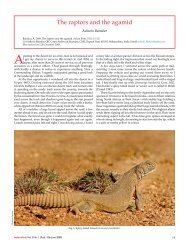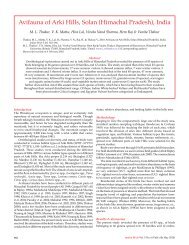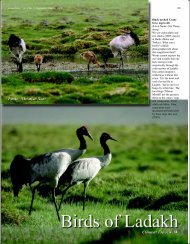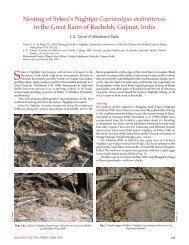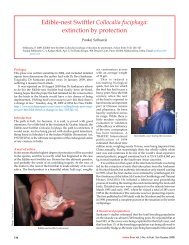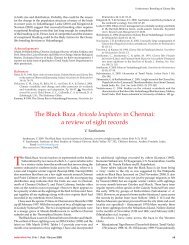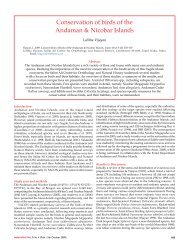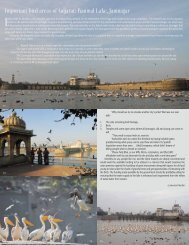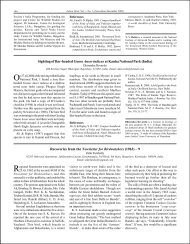Some significant records of birds from the central Indian highlands of ...
Some significant records of birds from the central Indian highlands of ...
Some significant records of birds from the central Indian highlands of ...
- No tags were found...
You also want an ePaper? Increase the reach of your titles
YUMPU automatically turns print PDFs into web optimized ePapers that Google loves.
98<strong>Indian</strong> Birds Vol. 1 No. 5 (September-October 2005)<strong>Some</strong> <strong>significant</strong> <strong>records</strong> <strong>of</strong> <strong>birds</strong> <strong>from</strong> <strong>the</strong> <strong>central</strong> <strong>Indian</strong> <strong>highlands</strong> <strong>of</strong> Madhya PradeshR. Jayapal* 1 , Qamar Qureshi 1 , and Ravi Chellam 21Wildlife Institute <strong>of</strong> India, PO Box:18, Chandrabani, Dehradun 248001, Uttaranchal.2UNDP-India, 55 Lodi Estate, New Delhi 110003. *Corresponding author. Email: jayapal@wii.gov.inIntroductionThe <strong>central</strong> <strong>Indian</strong> <strong>highlands</strong> in <strong>the</strong> state<strong>of</strong> Madhya Pradesh comprise <strong>the</strong>Satpura and Vindhya Ranges which areseparated by River Narmada. They areornithologically little explored, with just ahandful <strong>of</strong> papers published on localavifauna: Moss King (1911) <strong>from</strong> Damoh andSagar, Whitehead (1911) <strong>from</strong> Sehore,D’Abreu (1912) <strong>from</strong> Balaghat, Osmaston(1922) <strong>from</strong> Pachmarhi, Briggs (1931) <strong>from</strong>Mhow, Hewetson (1939) <strong>from</strong> Betul, Newtonet al. (1986) <strong>from</strong> Kanha, Tyabji (1994) <strong>from</strong>Bandhavgarh, Mehta (1998) <strong>from</strong> Bori and,more recently, Pasha et al. (2004) <strong>from</strong> Pench.Extensive surveys were however carried outin western and nor<strong>the</strong>rn Madhya Pradesh,mostly north <strong>of</strong> <strong>the</strong> Vindhyas (Edwin-Barnes1886; Ali and Whistler 1939, and 1940).Hewetson’s (1956) comprehensive account<strong>of</strong> all his bird observations across <strong>the</strong> regionwas ano<strong>the</strong>r major document on <strong>central</strong><strong>Indian</strong> avifauna. The only publishedscientific collections <strong>from</strong> <strong>the</strong> <strong>central</strong><strong>highlands</strong> were by D’Abreu (1912, and 1935)for Nagpur Museum. The o<strong>the</strong>r collection,by Dr Walter Koelz (1929-1950), currentlyhoused at University <strong>of</strong> Michigan Museum<strong>of</strong> Zoology, remained largely unknown tillRasmussen and Anderton (2005)catalogued it.The Wildlife Institute <strong>of</strong> India (WII)undertook a survey <strong>of</strong> breeding land <strong>birds</strong><strong>of</strong> <strong>the</strong> <strong>central</strong> <strong>highlands</strong> in Madhya Pradeshas part <strong>of</strong> an ongoing project on <strong>the</strong>Protected Area network in <strong>central</strong> India. Thesurvey was conducted between Februaryand July <strong>from</strong> 2002 to 2004, with its basecampat Pench Tiger Reserve (MadhyaPradesh), where we carried out year-roundobservations. We divided <strong>the</strong> region intoeleven areas and surveyed <strong>the</strong>m as per <strong>the</strong>following itinerary [Note that <strong>the</strong> coverage<strong>of</strong> districts under each subregion may bewhole or in part]:• Malwa Plateau (Jhabua, Dhar, Indore, andDewas districts): 25-27.v.2004.• Nimar Hills (Barwani, West Nimar, andEast Nimar districts): 22-30.v.2004.• Lower Narmada Valley (West Nimar,Dewas, Harda, Sehore, and Hoshangabaddistricts): 24-26.ii.2002; 22-30.v.2004.• Sagar-Damoh Plateau (Sagar and Damohdistricts): 14-21.vi.2004.• Betul Plateau (Betul district): 26.iv-5.v.2004.• Satpura Range (Hoshangabad, Betul, andChhindwara districts): 6-13.v.2004.• Seoni-Chhindwara Plateau (Chhindwara,Narsimhapur, and Seoni districts): Mostpart <strong>of</strong> <strong>the</strong> study period.• South Maikal Range (Mandla, Balaghat,and Dindori districts): 10-21.vi.2002.• East Maikal Range (Shahdol, Umaria, andKatni districts): 18-26.vi.2003.• Kaimur Hills (Jabalpur, Katni, Satna, andRewa districts): 18-26.vi.2003.• Vindhya scarplands (Chhatarpur, Panna,and Satna districts): 27-30.vi.2003.We took great care in speciesidentification, supporting each record withmeticulous observations on field characters,including vocalizations. All <strong>the</strong> doubtfulobservations were treated as unconfirmed<strong>records</strong>. This survey is, however, nei<strong>the</strong>rexhaustive nor complete, as several localities(e.g., Panna Tiger Reserve and Nimar Hills)were under sampled due to logistic and timeconstraints.We hope fur<strong>the</strong>r intensivestudies in <strong>the</strong> field will yield more accurateinformation on distribution and status <strong>of</strong><strong>central</strong> <strong>Indian</strong> <strong>birds</strong>.Several <strong>significant</strong> <strong>records</strong> and breedingrange extensions noticed during oursurveys are reported below.Crested Goshawk Accipiter trivirgatus InKanha Tiger Reserve a pair was seen nearKisli on 15.vi.2002 and ano<strong>the</strong>r pair atSalghat on 18.vi.2002. Probably a scarceresident in and around Kanha (south MaikalRange). D’Abreau (1935) collected onespecimen (A. t. indicus) <strong>from</strong> this locality.We also have two more disjunct <strong>records</strong><strong>from</strong> Satpura Plateau: From Bori WildlifeSanctuary, a male at Churna on 9.v.2004 anda female (?) near Dhain on 13.v.2004. Also acouple <strong>of</strong> winter <strong>records</strong> at Pench TigerReserve (a male on 11.i.1997 and a pair on26.ii.2004).Red Spurfowl Galloperdix spadicea Foundall along <strong>the</strong> forested hills <strong>from</strong> Indoredistrict in <strong>the</strong> west (one record at Simrole,24.v.2004) to south Maikal in <strong>the</strong> east (KanhaTiger Reserve, common) through Nimar Hills(Ashapur / Aulia, uncommon), Betul Plateau(Bhainsdehi Range, fairly common andRampur, common), Satpura Range (BoriWildlife Sanctuary, common), and Seoni-Chhindwara Plateau (Pench Tiger Reserve,common). Absent north <strong>of</strong> Narmada, ineastern Madhya Pradesh, where onlyPainted Spurfowl is found (see below).Painted Spurfowl G. lunulata Found insimilar habitat as Red Spurfowl but mainlyin eastern and <strong>central</strong> Madhya Pradesh.Quite frequent north <strong>of</strong> Narmada (Sagar-Damoh Plateau, Vindhya scarplands aroundPanna Tiger Reserve, Rewa Plateau, and eastMaikal Range (Bandhavgarh Tiger Reserve).South <strong>of</strong> Narmada River, found in sympatrywith Red Spurfowl in Bori-Pachmarhi Plateauand Pench Tiger Reserve, <strong>of</strong>ten in <strong>the</strong> samelocality. However, its apparent absence <strong>from</strong>Kanha Tiger Reserve (south Maikal Range)is intriguing and requires fur<strong>the</strong>rinvestigation. Hewetson (1956) hadrecorded it <strong>from</strong> Balaghat district.Red Junglefowl Gallus gallus Occurs in <strong>the</strong>sal Shorea robusta forests <strong>of</strong> easternMadhya Pradesh <strong>from</strong> east Maikal throughsouth Maikal Range south to <strong>the</strong> teak-Tectona grandis dominant Pench TigerReserve in Seoni district.Grey Junglefowl G. sonneratii Found insou<strong>the</strong>rn Madhya Pradesh <strong>from</strong> East NimarHills (Aulia Range, very scarce) throughBetul Hills (Bhainsdehi Range and northBetul division, fairly common) up to SatpuraRange (Bori Wildlife Sanctuary, verycommon). Ali and Whistler (1940) had adoubtful record <strong>of</strong> a female, fur<strong>the</strong>r west<strong>from</strong> Manpur, Indore district. Apparently,River Pench, running north-south, forms abarrier between G. gallus and G. sonneratiiin <strong>central</strong> India. But <strong>the</strong> reported (Dhamgeand Banubakode 2000) occurrence <strong>of</strong> GreyJunglefowl in Pench Tiger Reserve(Maharashtra) west <strong>of</strong> River Pench requiresconfirmation, as we did not encounter ei<strong>the</strong>r<strong>of</strong> <strong>the</strong> Gallus species during our four visitsto <strong>the</strong> Maharashtra section <strong>of</strong> Pench TigerReserve.Not seen in western Madhya Pradesh, i.e.,west Nimar Hills and Malwa Plateau, <strong>from</strong>where <strong>the</strong>re are historical <strong>records</strong> (Ali andWhistler 1940). We speculate that <strong>the</strong> current<strong>central</strong> <strong>Indian</strong> population might have nowbecome separated <strong>from</strong> <strong>the</strong> Western Ghatspopulation.Oriental Turtle-Dove Streptopeliaorientalis The peninsular population (S. o.erythrocephala) is found along <strong>the</strong> hills <strong>of</strong>sou<strong>the</strong>rn and eastern Madhya Pradesh,breeding commonly at c.600m a.s.l., andhigher (Betul Plateau, Satpura Range,Mahadeo Hills and south and east Maikal
Range including Bandhavgarh TigerReserve). Not seen west <strong>of</strong> Betul (e.g. NimarHills). In winter, it spreads widely over wellwoodedparts <strong>of</strong> <strong>the</strong> entire region, along with<strong>the</strong> Himalayan migratory form S. o. meena.Both are <strong>of</strong>ten seen toge<strong>the</strong>r in <strong>the</strong> samelocality.Emerald Dove Chalcophaps indica Occursin moist deciduous forests <strong>of</strong> <strong>central</strong> andeastern Madhya Pradesh <strong>from</strong> SatpuraRange (Bori Wildlife Sanctuary-Pachmarhi)east through Pench and Kanha TigerReserves up to east Maikal Range in <strong>the</strong>north-east (e.g. Bandhavgarh TigerReserve). Absent <strong>from</strong> Vindhyas (e.g.Panna and Sagar-Damoh Plateau). Frequentin bamboo forests <strong>of</strong> <strong>the</strong> sal biome but lessso in teak forests.<strong>Indian</strong> Cuckoo Cuculus micropterus andCommon Cuckoo Cuculus canorus Bothcuckoos are commonly heard in summer andearly monsoon throughout well-woodedareas <strong>of</strong> <strong>the</strong> entire region. C. micropteruswas, however, not heard or seen west <strong>of</strong>Simrole (Indore district).Drongo Cuckoo Surniculus lugubris Songcommonly heard between June andSeptember throughout <strong>the</strong> forested tracts<strong>of</strong> <strong>central</strong> and eastern Madhya Pradesh(including East Nimar Hills, Betul Plateau,Satpura Range, Seoni-Chhindwara Plateau,east and south Maikal Ranges, Vindhyascarplands, and Sagar-Damoh Plateau). Notseen west <strong>of</strong> Khandwa. Surprisingly few<strong>records</strong> <strong>from</strong> <strong>central</strong> India in <strong>the</strong> past (e.g.Tyabji 1994, Bandhavgarh). Host speciesimperfectly known, though twice seenchased aggressively by nesting AshyDrongos Dicrurus leucophaeus (nearKarmajhiri, Pench Tiger Reserve on15.vi.2003 and at Mukki, Kanha TigerReserve on 19.vi.2002).The local movements <strong>of</strong> this populationare, however, unclear. It is most probably asummer / monsoon breeding visitor to<strong>central</strong> India. We had no winter <strong>records</strong> inPench Tiger Reserve, during our stay in1996-1997, 2002-2003, and 2003-2004. But <strong>the</strong>possibility <strong>of</strong> <strong>birds</strong> having been overlookedwhen <strong>the</strong>y were not calling cannot be ruledout.Oriental Scops-Owl Otus sunia Foundalong <strong>the</strong> hill-forests <strong>of</strong> sou<strong>the</strong>rn andeastern Madhya Pradesh <strong>from</strong> Betul Plateaueast through Satpura Range, Mahadeo hills,Seoni Plateau, south and east Maikal. Thedistribution range in <strong>the</strong> region almostidentical to that <strong>of</strong> Oriental Turtle-Dove(fur<strong>the</strong>r spatial analyses planned). No<strong>the</strong>ard west <strong>of</strong> Betul. Very vocal <strong>from</strong> early<strong>Indian</strong> Birds Vol. 1 No. 5 (September-October 2005)March to late May. Surprisingly fewhistorical <strong>records</strong> <strong>from</strong> <strong>central</strong> India(Osmaston 1922 <strong>from</strong> Pachmarhi,; Hewetson1939 <strong>from</strong> Betul).Forest Eagle-Owl Bubo nipalensis Rareresident in Pench Tiger Reserve, Seonidistrict. Seen one adult roosting on a hugeTerminalia arjuna tree along <strong>the</strong> banks <strong>of</strong>River Pench in Cheetaghat area on18.iv.2004. Ano<strong>the</strong>r bird was photographedat Raiyagazza (date unknown) (Sen andDungriyal 2004). Apparently an addition to<strong>the</strong> <strong>central</strong> <strong>Indian</strong> avifauna.We also suspect seeing one bird nearChurna, Bori Wildlife Sanctuary on 9.v.2004.Interestingly, Mehta (1998) has recorded itas a rare resident in Bori Wildlife Sanctuary.Fur<strong>the</strong>r field surveys are required todetermine its status in <strong>central</strong> India.Brown Hawk-Owl Ninox scutulata A scarceresident in <strong>central</strong> and eastern MadhyaPradesh confined to <strong>the</strong> dense forests <strong>of</strong>Satpura Range, Mahadeo Hills, SeoniPlateau, south and east Maikal Ranges, andalso in and around Panna Tiger Reserve in<strong>the</strong> Vindhyas (calls heard near Hinautabarrier on 27.vi.2003 and one pair wasobserved being mobbed by o<strong>the</strong>r <strong>birds</strong> nearPawai on Panna-Katni route on 29.vi.2003).White-rumped Needletail-SwiftZoonavena sylvatica Occurs <strong>from</strong>Chorbahuli on Nagpur-Seoni Highway(26.vii.2002, 7.iv.2003; 2.vi.2003) norththrough Mahadeo Hills, Seoni Plateau, andsouth Maikal Range till east Maikal Rangein Umaria district (Bandhavgarh TigerReserve). Not seen west <strong>of</strong> Chhindwaratown.Blue-bearded Bee-eater Nyctyornisa<strong>the</strong>rtoni Two small disjunct populationsexist in Madhya Pradesh. One in <strong>the</strong> SatpuraRange (Bori Wildlife Sanctuary andPachmarhi) and ano<strong>the</strong>r in and aroundBandhavgarh Tiger Reserve. Possibly alsoin Deogarh hills in Shahdol district, not far<strong>from</strong> Bandhavgarh where calls were heardin a dense sal patch near Kumerhin on19.vi.2003. Not seen anywhere else. Ourobservations largely agree with <strong>the</strong>distribution map in Kazmierczak (2000).However, <strong>the</strong> range in Rasmussen andAnderton (2005) includes <strong>the</strong> entire stretch<strong>of</strong> <strong>central</strong> <strong>Indian</strong> <strong>highlands</strong>.Malabar Pied Hornbill Anthracoceroscoronatus Distributed in <strong>central</strong>, sou<strong>the</strong>rn,and eastern Madhya Pradesh. Our surveyyielded four disjunct populations: 1) NorthBetul Division (Rampur) and Satpura Range(Bori Wildlife Sanctuary– Pachmarhi), 2)Seoni Plateau (Pench Tiger Reserve) and99south Maikal Range (Kanha Tiger Reserve),3) East Maikal Range (Bandhavgarh TigerReserve), and 4) Deogarh hills in Shahdoldistrict (Kumerhin Reserve).Rufous Woodpecker Celeus brachyurusCentral and eastern Madhya Pradeshincluding Satpura Range, Seoni-ChhindwaraPlateau, and south and east Maikal Range.Distribution limits in <strong>the</strong> region remarkablyidentical to that <strong>of</strong> Emerald Dove (fur<strong>the</strong>rspatial analyses planned). More frequent insal biome than teak forests.Small Yellow-naped Woodpecker Picuschlorolophus Fairly common in lessdisturbedforests in Satpura Range (BoriWildlife Sanctuary and Mahadeo Hills),Seoni Plateau (Pench Tiger Reserve), andsouth Maikal Range (Kanha Tiger Reserveeast to Amarkantak). Not found north <strong>of</strong>Narmada. Our observations agree with <strong>the</strong>range map in Kazmierczak (2000), but notwith Grimmett et al. (1998) or Rasmussen andAnderton (2005).Little Scaly-bellied Green WoodpeckerPicus xanthopygaeus Commonly found ina wide variety <strong>of</strong> forest types in <strong>central</strong> andeastern Madhya Pradesh, <strong>from</strong> north BetulDivision through Satpura Range, MahadeoHills, Seoni-Chhindwara Plateau, and southand east Maikal Ranges. One unconfirmedsighting around Panna Tiger Reserve (a birdin flight near Akola on Panna-Amanganjroad on 29.vi.2003). Contrary to existingliterature (Grimmett et al. 1998; Kazmierczak2000), we did not come across it in westernMadhya Pradesh including Malwa Plateauand Nimar Hills (Shahpur in Betul district isour westernmost record) nor in Sagar-Damoh Plateau.Singing Bush-Lark Mirafra cantillansLocally distributed in western and sou<strong>the</strong>rnMadhya Pradesh. Absent <strong>from</strong> most <strong>of</strong><strong>central</strong> and eastern Madhya Pradeshespecially north <strong>of</strong> Narmada River.Red-winged Bush-Lark Mirafraerythroptera Widespread in <strong>the</strong> regionexcept sal-dominant eastern MadhyaPradesh (Maikal and Kaimur Hills). Alsoabsent in Satpura Range. Very common onMalwa Plateau (Simrole-Mhow road) andSagar-Damoh Plateau (Nauradehi WildlifeSanctuary). Generally scarcer elsewhere.<strong>Indian</strong> Short-toed Lark Calandrella raytalVery few historical <strong>records</strong> <strong>from</strong> <strong>the</strong> region(Hewetson 1956 <strong>from</strong> Narmada). Certainly,more widely distributed in <strong>the</strong> region thanpast <strong>records</strong> indicate. All our sightings wereinvariably along sandy river banks, asfollows: Along Narmada River: NearJabalpur (21.vi.2004), near Hoshangabad
100(26.ii.2002; 2.xii.2002) and, several betweenOmkareshwar and Mandleshwar (26.v.2004).Along Ken River: Near Rajgarh, Pannadistrict (29.vi.2003). Along Bearma River:Near Kudpura, Damoh district (21.vi.2004).Along Kanhan River: One pair nearPandhurna, Chhindwara district (22.v.2004).Sykes’s Crested Lark Galerida deva Quitecommon in western and nor<strong>the</strong>rn MadhyaPradesh. Absent <strong>from</strong> higher hills (abovec.500m a.s.l.) <strong>of</strong> Satpura Range and <strong>the</strong>eastern sal country. Ken River in <strong>the</strong> northand River Pench in <strong>the</strong> south probably form<strong>the</strong> distribution limits, east <strong>of</strong> which we haveno <strong>records</strong>. Our easternmost record in <strong>the</strong>north is near Rajgarh, Panna district(29.vi.2003), and in <strong>the</strong> south nearKumbhapani, Chhindwara district(26.iv.2004).Scarlet Minivet Pericrocotus flammeusOccurs in two disjunct breedingpopulations. One in north Betul Division(Rampur) and Satpura Range (Bori WildlifeSanctuary-Pachmarhi) but not MahadeoHills. Ano<strong>the</strong>r in south Maikal Range(Kanha Tiger Reserve east to Amarkantak).Not seen anywhere else.Reports <strong>of</strong> its occurrence (Tyabji 1994;Pasha et al. 2004) in o<strong>the</strong>r parts <strong>of</strong> <strong>the</strong> regionis probably owing to confusion with <strong>the</strong>similar-looking Long-tailed Minivet P.ethologus, which is a common wintermigrant to <strong>central</strong> India.Pied Flycatcher-Shrike Hemipus picatusWe recorded this species in three disjunctlocalities: 1) South Betul Division(Bhainsdehi Range), 2) North Betul division– Satpura Range (Bori Wildlife Sanctuary),and 3) South Maikal Range (Kanha TigerReserve east to Amarkantak). There is anold record <strong>from</strong> Sagar-Damoh district (MossKing 1911), but we do not have any <strong>records</strong><strong>from</strong> north <strong>of</strong> Narmada River.The <strong>birds</strong> in <strong>central</strong> India are seeminglymore withdrawn and less confiding thannor<strong>the</strong>rn population in <strong>the</strong> Himalayas.Black-crested Bulbul Pycnonotusmelanicterus We have only two <strong>records</strong> <strong>of</strong>this species and both are restricted to northBetul Division - Satpura Range. A pair nearRampur, Betul (27.iv.2004) and a small flock<strong>of</strong> four near Tamia, Chhindwara district(22.v.2004). Not seen elsewhere, includingBori Wildlife Sanctuary, which lies between<strong>the</strong>se two localities. Apparently, <strong>the</strong>re areold <strong>records</strong> <strong>from</strong> Pench Tiger Reserve(Sterndale 1887), but this population is notseen anymore.Red-whiskered Bulbul Pycnonotus jocosusRecorded only in Betul Plateau (both south<strong>Indian</strong> Birds Vol. 1 No. 5 (September-October 2005)Betul and north Betul divisions) andSatpura Range (Bori Wildlife Sanctuary –Pachmarhi extending down to MahadeoHills, Tamia in Chhindwara district). Despiteits very restricted range in <strong>the</strong> region, it iscuriously abundant wherever it occurs.Apparently <strong>the</strong>re is ano<strong>the</strong>r disjunctpopulation in Kanha Tiger Reserve (Newtonet al. 1986), but we could not locate it.White-browed Bulbul Pycnonotus luteolusOccurs only in Seoni-Chhindwara Plateau,<strong>the</strong> nor<strong>the</strong>rn limit <strong>of</strong> its distribution in<strong>central</strong> India. Very scarce, thoughreportedly locally common in Nagpur city.Our <strong>records</strong> include two pairs nearPandhurna in Chhindwara district(22.v.2004) and <strong>birds</strong> sighted on threedifferent occasions in Pench Tiger Reserve,Seoni district (a pair at Karmajhiri in 1996and on 6.ix.2003, and ano<strong>the</strong>r pair near Turiagate on 18.ii.2004).Malabar Whistling-Thrush Myophonushorsfieldii We have four <strong>records</strong>: SouthBetul Division (Kukru, Bhainsdehi Range:fairly common), north Betul Division-Satpura Range (also frequent in <strong>the</strong>adjacent Mahadeo Hills, Tamia,Chhindwara district), near Shahpura inDindori district (two sightings on18.vi.2003), and in Deogarh hills nearKumerhin in Shahdol district (one sightingon 19.vi.2003).Orange-headed Thrush Zoo<strong>the</strong>ra citrinacyanotus Found commonly in <strong>the</strong> forests<strong>of</strong> sou<strong>the</strong>rn and eastern Madhya Pradesh<strong>from</strong> East Nimar Hills (our western-mostrecord: Ashapur, Aulia Range on 23.v.2004)east through Betul Plateau, Satpura Range,Seoni-Chhindwara Plateau, and south andeast Maikal Range north to BandhavgarhTiger Reserve. Apparently occurs inVindhya scarplands (Panna Tiger Reserve,K. Yoganand, verbally). Absent <strong>from</strong>western Madhya Pradesh (Malwa Plateauand West Nimar Hills?), and north-<strong>central</strong>Madhya Pradesh (Sagar-Damoh Plateau).<strong>Indian</strong> Blackbird Turdus simillimus Seenall along <strong>the</strong> sou<strong>the</strong>rn hills <strong>from</strong> MalwaPlateau (Mandu, 26.v.2004; Simrole,24.v.2004), Nimar Hills (Ashapur, AuliaRange, 23.v.2004), Betul Plateau (Kukru,Bhainsdehi Range, 27.iv.2004-5.v.2004),Satpura Range (Mahadeo hills, Tamia,Chhindwara district, 22.v.2004), SeoniPlateau (Rukhad and Kurai, Pench TigerReserve), and south Maikal east toAmarkantak and also Deogarh hills,Kumerhin, Shahdol district (19.vi.2003). Wehave, however, no <strong>records</strong> <strong>from</strong> east MaikalRange (e.g. Bandhavgarh Tiger Reserve).Only a summer / monsoon visitor to PenchTiger Reserve (<strong>from</strong> early May toSeptember), and presumably so in o<strong>the</strong>rparts <strong>of</strong> <strong>the</strong> region.White-rumped Shama Copsychusmalabaricus All our <strong>records</strong> confined tosouth-eastern Madhya Pradesh. FromPench Tiger Reserve (Very rare. Only threesightings: one male near Bodanalla tank on25.xii.1996, ano<strong>the</strong>r in a bamboo thicketalong Kadasi Nalla on 17.ix.2003 and, a pairnear Bodanalla on 27.ii.2004) to south MaikalRange (Kanha Tiger Reserve: quitecommon) east to Amarkantak south <strong>of</strong>Narmada River.<strong>Indian</strong> Chat Cercomela fusca Occurs west<strong>of</strong> a diagonal line <strong>from</strong> Panna to Khargonalong <strong>the</strong> Narmada River. Our easternmost<strong>records</strong> along this line <strong>from</strong> north-east tosouth-west in <strong>the</strong> region are as follows:Panna-Amanganj road (29.vi.2003),Bilayatkalan on Katni-Umaria road(17.vi.2003), Jabalpur city (30.vi.2003;22.vi.2004), Suatala on Narasimhapur-Sagarroad (13.vi.2004), near Hoshangabad(26.ii.2002), between Omkareshwar andMandleshwar (26.v.2004), and Khargontown (28.v.2004).Our observations largely agree with <strong>the</strong>range map in Kazmierczak (2000). Curiously,we have one doubtful sighting far <strong>from</strong> thisline near Mansar on Nagpur-Seoni Highwayon 29.v.2004.Spotted Babbler Pellorneum ruficepsRecorded <strong>from</strong> <strong>central</strong> and eastern MadhyaPradesh: South Betul (Kukru, BhainsdehiRange), north Betul (Rampur), SatpuraRange (Bori Wildlife Sanctuary-Pachmarhi,but not found in <strong>the</strong> adjacent MahadeoHills), south and east Maikal Ranges northto Bandhavgarh. Not seen west <strong>of</strong> Betul.<strong>Indian</strong> Scimitar-Babbler Pomatorhinushorsfieldii Range nearly identical to that <strong>of</strong>Spotted Babbler, <strong>of</strong>ten found toge<strong>the</strong>r in <strong>the</strong>same locality. In addition, also recorded <strong>from</strong>Mahadeo Hills, near Tamia in Chhindwaradistrict (22.v.2004), Pench Tiger Reserve (apair at Kadasi Nalla on 17.ix.2003; also seeD’Abreau 1935), and Vindhya scarplands(Panna Tiger Reserve: K. Yoganandverbally; also distinct dueting calls heard<strong>from</strong> a dense bamboo forest near Shikarpura,Panna district on 29.vi.2003).Common Babbler Turdoides caudatusWidespread but generally less common. Wedid not have any <strong>records</strong> <strong>from</strong> most parts <strong>of</strong>south and east Maikal Ranges (except oneflock at Manpur near Bandhavgarh TigerReserve on 25.vi.2003); probably absent<strong>from</strong> south-eastern Madhya Pradesh.
Quaker Tit-Babbler Alcippe poioicephalaA bird <strong>of</strong> <strong>the</strong> hill-forests. Its range nearlyoverlaps with that <strong>of</strong> Spotted Babbler.However, we have one record <strong>from</strong> west <strong>of</strong>Betul, near Dhulkot, West Nimar district(28.v.2004).Both, this species and Spotted Babblerare curiously absent <strong>from</strong> several localitieswhere seemingly suitable habitats arepresent (Aulia in East Nimar Hills, MahadeoHills in Chhindwara district, and Kurai hillsin Pench Tiger Reserve).Rufous-fronted Prinia Prinia buchananiMainly found in western Madhya Pradeshextending east to Rukhad (in Pench TigerReserve, very scarce) in <strong>the</strong> south and Satnain <strong>the</strong> north (a pair seen near Satna Riverbridge between Nagod and Satna on26.vi.2003). No <strong>records</strong> [absent?] <strong>from</strong><strong>central</strong> (Satpura Range and Mahadeo Hills)and eastern Madhya Pradesh (MaikalRanges).Ashy Prinia Prinia socialis Recordedalmost throughout <strong>the</strong> region except nor<strong>the</strong>asternMadhya Pradesh includingBandhavgarh (Absent <strong>from</strong> east MaikalRange north <strong>of</strong> Narmada River?). See Tyabji(1994) for his comments on its reportedabsence <strong>from</strong> Bandhavgarh Tiger Reserve.Striated Marsh-Warbler Megaluruspalustris Very few historical <strong>records</strong>(D’Abreau 1935). Possibly more widespreadthan old <strong>records</strong> indicate (Rasmussen andAnderton 2005). We have recorded <strong>from</strong>three localities: Along Narmada River:several between Omkareshwar andMandleshwar (26.v.2004). Along Ken River:One individual near <strong>the</strong> bridge betweenRajgarh and Panna (29.vi.2003). Along RiverPench: One pair close to Tikari village, PenchTiger Reserve on 15.viii.2003.Asian Brown Flycatcher Muscicapadauurica Earlier known to breed onlyaround <strong>the</strong> hills <strong>of</strong> Malwa Plateau (Briggs1931; Ali and Ripley 1982). We discoveredano<strong>the</strong>r disjunct breeding population insouth Betul Division (Kukru, BhainsdehiRange, scarce) and also possibly in <strong>the</strong>adjacent Gawilgarh hills, Melghat TigerReserve, Maharashtra. Hewetson (1956)recorded it <strong>from</strong> Melghat as a probablebreeder, but not <strong>from</strong> Betul. Ourwesternmost record is <strong>from</strong> <strong>the</strong> hills <strong>of</strong>Simrole (24.v.2004), where it is notuncommon.Rasmussen and Anderton (2005) showthat <strong>the</strong> species breeds extensively across<strong>the</strong> <strong>central</strong> <strong>Indian</strong> <strong>highlands</strong> east to MaikalRanges. Though we did not come acrossthis species east <strong>of</strong> Betul, intensive searches<strong>Indian</strong> Birds Vol. 1 No. 5 (September-October 2005)may yield fur<strong>the</strong>r breeding <strong>records</strong>. Mehta(1998) recorded it as an uncommon residentin Bori Wildlife Sanctuary. Incidentally, wehave three winter <strong>records</strong> <strong>from</strong> Pench TigerReserve, Seoni district (16.xi.2003,23.xii.2003, 2.ii.2004; see also Pasha et al.2004).White-throated Fantail Rhipiduraalbicollis Recorded <strong>from</strong> three disjunctareas, all south <strong>of</strong> Narmada River: 1) SouthBetul Division (Bhainsdehi Range, Kukru),2) North Betul Division-Satpura Range (BoriWildlife Sanctuary-Pachmarhi) both <strong>the</strong>sepopulations belong to <strong>the</strong> race R. a.albogularis, and 3) South Maikal Range(Kanha east to Amarkantak), belonging toR. a. orissae. There is one unconfirmedsighting (apparently R. a. albogularis) <strong>from</strong>Pench Tiger Reserve, Seoni district(Sayantan Biswas, verbally.).Curiously, some individuals observed inBori Wildlife Sanctuary and Kukru Reserve,Betul district, looked very similar to R. a.orissae.Spotted Creeper Salpornis spilonotus Onlytwo sightings during <strong>the</strong> survey, both <strong>from</strong>Nauradehi Wildlife Sanctuary, Sagar district.One pair near Mohali on 19.vi.2004, anindividual near Chevla Talab on 20.vi.2004.Apparently not uncommon in Panna TigerReserve (K. Yoganand, verbally.).Purple-rumped Sunbird Nectariniazeylonica All our <strong>records</strong> are <strong>from</strong> south<strong>central</strong>Madhya Pradesh. Uncommon inBhainsdehi Range, south Betul Division andone pair near Pandhurna, Chhindwaradistrict on 22.v.2004. Reportedly occurs in<strong>the</strong> adjacent Satpura Range as well (Mehta1998, <strong>from</strong> Bori Wildlife Sanctuary), thoughwe did not see any <strong>the</strong>re.Grey-headed Starling Sturnus malabaricusRecorded <strong>from</strong> forested tracts <strong>of</strong> <strong>central</strong> andeastern Madhya Pradesh <strong>from</strong> SatpuraPlateau (Bori Wildlife Sanctuary-Pachmarhi)east to Maikal Ranges (Kanha andBandhavgarh Tiger Reserve) through Seoni-Chhindwara Plateau (Pench Tiger Reserve),Sagar-Damoh Plateau (Nauradehi WildlifeSanctuary) and Vindhya scarplands (PannaTiger Reserve) in <strong>the</strong> north. All <strong>the</strong> <strong>records</strong>were between April and July, indicating abreeding population, and presence <strong>of</strong>juveniles fur<strong>the</strong>r confirms <strong>the</strong>ir breedingstatus in <strong>the</strong> region. Not recorded west <strong>of</strong>Bori (including Betul Plateau?). Probablywidespread in winter across <strong>the</strong> entireregion.Jungle Myna Acrido<strong>the</strong>res fuscusObserved only <strong>from</strong> south Maikal Range insouth-eastern Madhya Pradesh. Is quite101common in and around Kanha but veryscarce east to Amarkantak. Distributionintriguingly very local and patchy. Records<strong>from</strong> o<strong>the</strong>r parts <strong>of</strong> <strong>the</strong> region arequestionable (Pasha et al. 1998, <strong>from</strong> PenchTiger Reserve).Ashy Drongo Dicrurus leucophaeus Themost surprising finding <strong>of</strong> <strong>the</strong> survey.Widely thought to be a winter visitor <strong>from</strong><strong>the</strong> Himalaya Range (Ali and Ripley 1983).We found several breeding <strong>birds</strong> during oursurvey, mostly in <strong>central</strong>, sou<strong>the</strong>rn, andeastern Madhya Pradesh <strong>from</strong> <strong>the</strong> SatpuraRange (Bori Wildlife Sanctuary-Pachmarhi),Mahadeo Hills (Tamia, Chhindwara district),Seoni Plateau (Pench Tiger Reserve), southMaikal Range (Kanha Tiger Reserve east toAmarkantak), and up to east Maikal Range(Bandhavgarh Tiger Reserve) in <strong>the</strong> nor<strong>the</strong>ast.Not found west (including BetulPlateau) or north <strong>of</strong> Bori. Quite commonwherever found. Territorial fights andcourtship behaviour are ra<strong>the</strong>r prolonged,beginning in <strong>the</strong> second week <strong>of</strong> April, whilenest construction starts around <strong>the</strong> first week<strong>of</strong> June. The fledglings are usually seen in<strong>the</strong> first week <strong>of</strong> July.The only breeding record <strong>from</strong> <strong>the</strong> region,in <strong>the</strong> past, was <strong>from</strong> Bandhavgarh (Tyabji1994). Poor coverage during <strong>the</strong> south-westmonsoon (when most parts <strong>of</strong> <strong>the</strong> regionbecome inaccessible) and similarity to <strong>the</strong>commoner Black Drongo D. macrocercusmight explain why <strong>the</strong> bird has beenconsistently under-reported <strong>from</strong> <strong>the</strong> region.Interestingly, Rasmussen and Anderton(2005) have shown a small residentpopulation in sou<strong>the</strong>rn Madhya Pradesh,citing Walter Koelz’s unpublishedcollections <strong>from</strong> <strong>central</strong> India.Widespread in winter throughout <strong>the</strong> wellwoodedparts <strong>of</strong> <strong>the</strong> region, when <strong>the</strong> localpopulation is probably augmented bywintering <strong>birds</strong> <strong>from</strong> <strong>the</strong> Himalayas.We strongly recommend fur<strong>the</strong>r intensivesurveys between May and July in o<strong>the</strong>rpeninsular hills as well (e.g. Eastern Ghats)for fur<strong>the</strong>r breeding <strong>records</strong>.Spangled Drongo Dicrurus hottentottus Weidentified four disjunct populations: 1)Satpura Range: common in Bori WildlifeSanctuary-Pachmarhi, (but not found inMahadeo Hills), 2) Seoni Plateau: very rarein Kurai Valley, Pench Tiger Reserve (onlytwo sightings: one pair on 3.v.2002, andano<strong>the</strong>r nesting pair on 7.vii.2003), 3) SouthMaikal Range (common in Kanha TigerReserve and scarce east to Amarkantak),and 4) East Maikal Range (fairly common inBandhavgarh Tiger Reserve east to Deogarh



